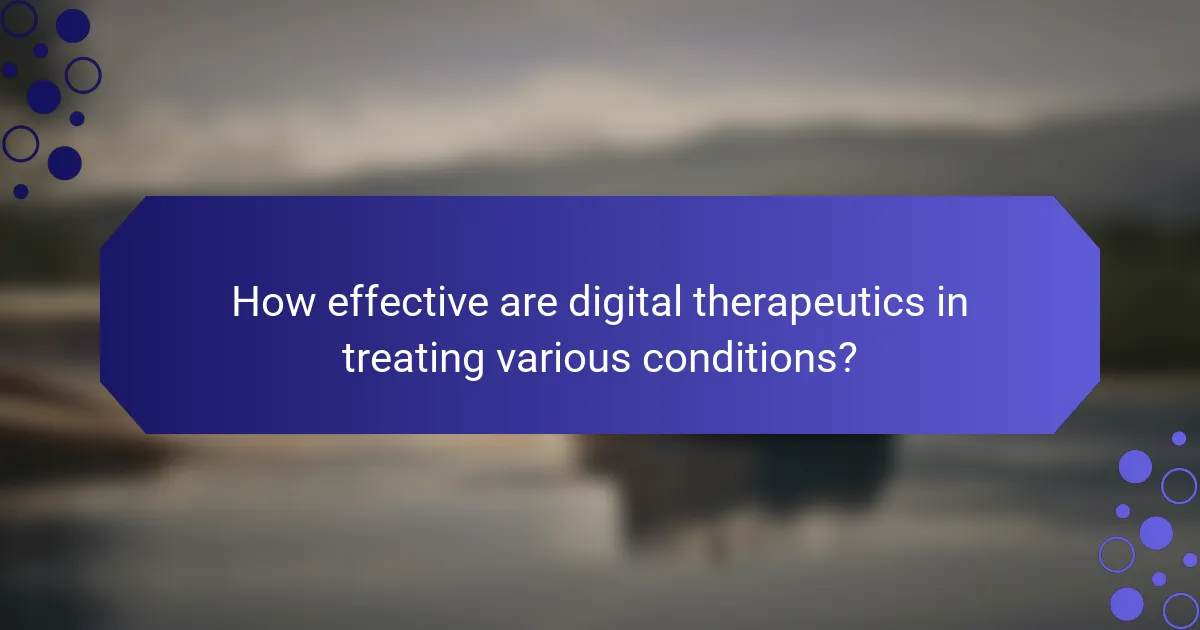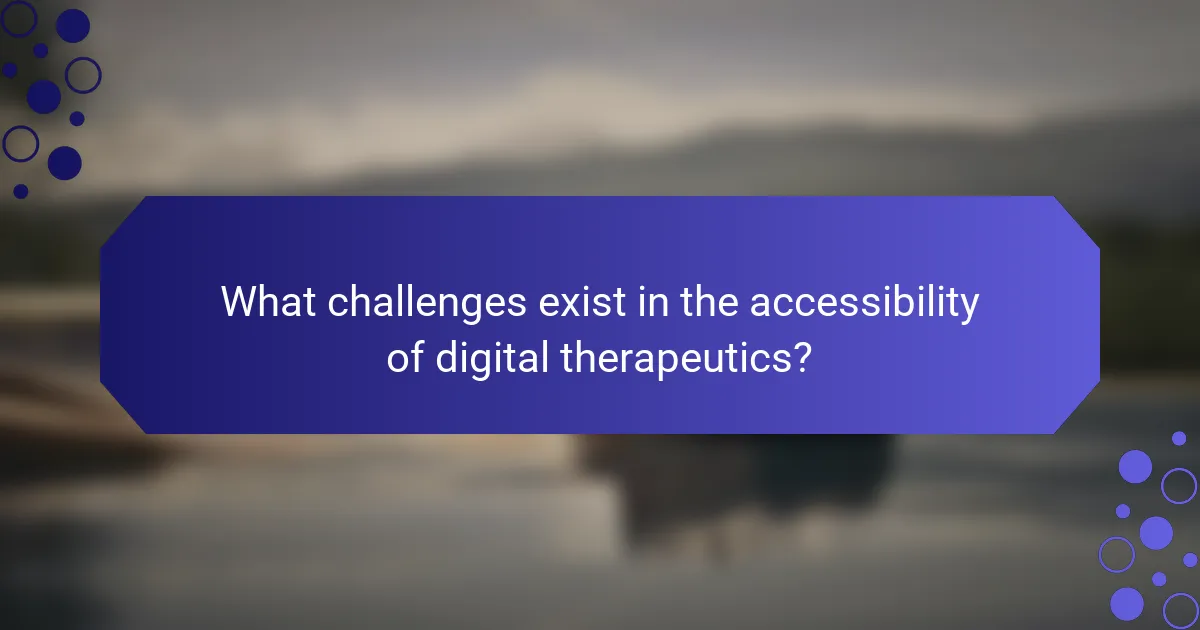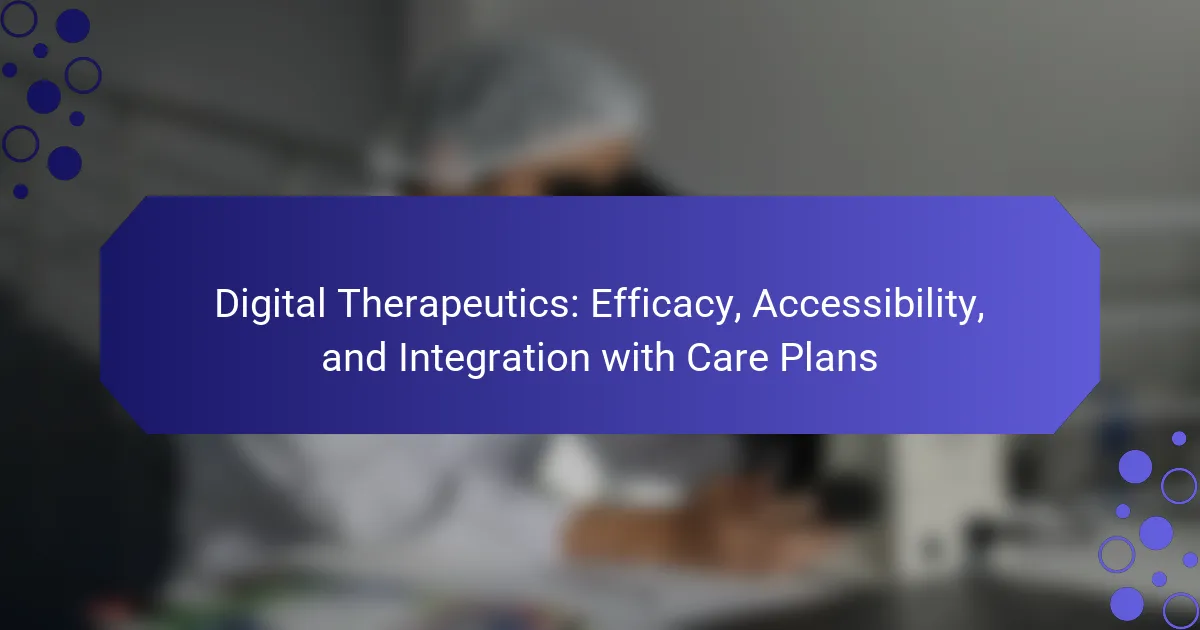Digital therapeutics offer measurable health outcomes, but challenges remain in accessibility and integration with traditional care plans. This article explores the efficacy of digital solutions across various conditions, highlights accessibility barriers, and discusses strategies for seamless integration into healthcare. Advances in technology and personalised treatment approaches will shape the future of digital therapeutics.

What are the core principles of digital therapeutics?
Digital therapeutics rely on three core principles: efficacy, accessibility, and integration with care plans. Efficacy ensures that these digital solutions deliver measurable health outcomes. Accessibility focuses on making treatments available to diverse populations through technology. Integration with care plans allows seamless incorporation of digital therapeutics into traditional healthcare, enhancing patient engagement and adherence.
How do digital therapeutics differ from traditional therapies?
Digital therapeutics differ from traditional therapies primarily in their delivery and accessibility. Digital therapeutics leverage technology to provide evidence-based interventions through software, enhancing patient engagement and monitoring. Traditional therapies often rely on in-person consultations and manual interventions, which can limit accessibility. Digital solutions can integrate seamlessly with care plans, offering real-time data and personalised feedback. This integration supports ongoing treatment adjustments, making digital therapeutics a more adaptable option for many patients.
What are the key components of successful digital therapeutic interventions?
Successful digital therapeutic interventions rely on three key components: evidence-based efficacy, seamless accessibility, and integration with existing care plans.
Evidence-based efficacy ensures that interventions are grounded in rigorous clinical research, demonstrating their effectiveness in treating specific conditions. Accessibility involves user-friendly platforms that cater to diverse populations, removing barriers to entry. Integration with care plans allows healthcare providers to incorporate digital therapeutics into patient treatment strategies, fostering a holistic approach to health management.
These components collectively enhance patient engagement and improve health outcomes, making digital therapeutics a valuable addition to modern healthcare.

How effective are digital therapeutics in treating various conditions?
Digital therapeutics are highly effective in treating various conditions, demonstrating significant outcomes in mental health, diabetes management, and chronic pain. Recent studies show that digital interventions can lead to a 30-50% reduction in symptoms for depression and anxiety. Furthermore, these therapies enhance patient engagement and adherence to treatment plans. Integration with traditional care models has proven beneficial, as it allows for personalised treatment adjustments based on real-time data. Accessibility remains a strong point, as digital therapeutics can reach underserved populations, ensuring broader health equity.
Which conditions have the strongest evidence for digital therapeutic efficacy?
Digital therapeutics demonstrate the strongest efficacy in managing conditions like diabetes, depression, anxiety, and substance use disorders. Evidence shows significant improvements in patient outcomes and adherence to treatment plans. For example, digital interventions for diabetes can lead to a 0.5% to 1% reduction in HbA1c levels. In mental health, studies indicate that digital therapeutics can reduce symptoms of depression by over 30%. These conditions benefit from tailored digital solutions that integrate seamlessly into existing care frameworks.
What metrics are used to assess the effectiveness of digital therapeutics?
Digital therapeutics are assessed using metrics like clinical outcomes, patient engagement, and cost-effectiveness. Key metrics include adherence rates, symptom reduction, and quality of life improvements. These metrics help evaluate both efficacy and integration into care plans. For example, a study may measure a 30% reduction in symptoms and a 20% increase in patient engagement, showcasing the therapy’s effectiveness.

What challenges exist in the accessibility of digital therapeutics?
Digital therapeutics face several accessibility challenges, including technological barriers, regulatory hurdles, and disparities in healthcare access. Many patients lack the necessary devices or internet connectivity to use these interventions effectively. Regulatory frameworks can slow the approval process, limiting timely access to beneficial therapies. Additionally, socioeconomic factors contribute to unequal access, with marginalised communities often facing greater obstacles in utilising digital health solutions.
How do socioeconomic factors influence access to digital therapeutics?
Socioeconomic factors significantly influence access to digital therapeutics by creating disparities in availability and affordability. Individuals from lower socioeconomic backgrounds often face barriers such as limited internet access, lack of digital literacy, and financial constraints. These factors can hinder their ability to utilise digital health solutions effectively. As a result, integrating digital therapeutics into care plans must consider these socioeconomic challenges to enhance accessibility and equity in healthcare.
What role does technology literacy play in the adoption of digital therapeutics?
Technology literacy is crucial for the adoption of digital therapeutics, as it enables effective use and integration into care plans. Individuals with higher technology literacy can better navigate digital platforms, understand treatment protocols, and engage with healthcare providers. This capability enhances patient adherence to therapeutic regimens and improves health outcomes. Additionally, organisations implementing digital therapeutics benefit from tech-savvy staff who can facilitate user training and support. As a result, technology literacy directly influences the efficacy and accessibility of digital therapeutic solutions.

How can digital therapeutics be integrated into existing care plans?
Digital therapeutics can be integrated into existing care plans by aligning them with clinical workflows. This ensures seamless communication between healthcare providers and patients.
First, assess patient needs to identify suitable digital therapeutics that complement traditional treatments. Next, train healthcare staff on the technology to enhance user adoption. Establish protocols for monitoring patient engagement and outcomes, allowing for timely adjustments to care plans. Finally, gather feedback from patients and providers to refine integration strategies continuously.
This approach enhances treatment efficacy, improves accessibility, and fosters a holistic care environment.
What are the best practices for incorporating digital therapeutics into treatment protocols?
Incorporating digital therapeutics into treatment protocols requires careful planning and integration. First, assess the specific needs of patients to ensure the selected digital therapeutic aligns with their treatment goals. Next, establish clear communication channels between healthcare providers and patients to facilitate engagement and adherence. Additionally, monitor patient progress through data analytics to adjust treatment plans effectively. Finally, ensure compliance with regulatory standards to maintain safety and efficacy in digital therapeutic applications.
How do healthcare providers perceive the integration of digital therapeutics?
Healthcare providers generally perceive the integration of digital therapeutics positively, recognising their potential to enhance patient care. Many providers appreciate the increased accessibility these tools offer, allowing for more personalised treatment plans. Digital therapeutics can improve patient engagement and adherence, which are crucial for effective outcomes. Moreover, some providers express concerns regarding data privacy and the need for robust clinical evidence to support these interventions. Overall, the integration of digital therapeutics is seen as a beneficial evolution in modern healthcare, though challenges remain in standardisation and acceptance.

What are the unique attributes that differentiate specific digital therapeutic solutions?
Digital therapeutic solutions differ through unique attributes such as targeted conditions, user engagement methods, and integration capabilities. These variations enhance their efficacy and accessibility within care plans. For instance, some solutions focus specifically on mental health, while others address chronic disease management. Additionally, the level of user personalisation can vary, influencing adherence and outcomes. Integration with existing healthcare systems also sets certain solutions apart, affecting their overall impact on patient care.
Which digital therapeutic platforms are leading in user engagement and satisfaction?
Leading digital therapeutic platforms in user engagement and satisfaction include Omada Health, Pear Therapeutics, and Noom. These platforms excel in personalised care, user-friendly interfaces, and integration with existing healthcare systems. Omada Health focuses on chronic disease management, achieving high user retention rates. Pear Therapeutics offers evidence-based therapies, enhancing user satisfaction through clinical validation. Noom combines behavioural science with technology, resulting in significant user engagement metrics.
What innovative features are emerging in new digital therapeutic applications?
Innovative features in new digital therapeutic applications include personalised treatment plans, real-time data tracking, and AI-driven insights. These advancements enhance patient engagement, improve adherence to care plans, and facilitate seamless integration with healthcare providers. Enhanced user interfaces and gamification elements further boost user interaction, making therapies more appealing.

What are the potential future trends in digital therapeutics?
Digital therapeutics will increasingly focus on personalised treatment, integration with traditional healthcare, and improved accessibility. Advances in artificial intelligence will enhance data analysis for tailored interventions. As regulations evolve, digital therapeutics will gain wider acceptance in clinical settings. Moreover, the emphasis on mental health solutions will drive innovation in this sector. Enhanced user engagement through gamification and real-time feedback will also shape future trends.
How might regulatory changes impact the landscape of digital therapeutics?
Regulatory changes can significantly reshape the digital therapeutics landscape. New guidelines may enhance efficacy standards, improve accessibility, and promote better integration with care plans.
For instance, stricter regulations may require more rigorous clinical trials, ensuring higher efficacy rates. This could lead to increased trust among healthcare providers and patients. Enhanced accessibility may arise from regulations that support reimbursement for digital therapeutics, making them more financially viable for patients.
Moreover, integration with care plans could be streamlined as regulations encourage collaboration between digital therapeutics developers and healthcare professionals. This alignment can enhance patient outcomes through personalised treatment approaches.
Overall, regulatory changes are likely to foster a more robust framework for digital therapeutics, ultimately benefiting patients and healthcare systems.
What advancements in technology could enhance digital therapeutic effectiveness?
Advancements in technology can significantly enhance the effectiveness of digital therapeutics through improved data analytics, personalised interventions, and seamless integration with healthcare systems. Enhanced algorithms can analyse patient data in real-time, enabling tailored treatment plans. Wearable devices can provide continuous monitoring, offering insights into patient behaviour and progress. Artificial intelligence can facilitate predictive modelling, identifying potential health issues before they arise. Additionally, improved user interfaces can enhance patient engagement and adherence to therapeutic programmes. Integrating digital therapeutics with electronic health records can streamline care coordination, ensuring that healthcare providers have access to comprehensive patient data for informed decision-making.
What strategies can users employ to maximise the benefits of digital therapeutics?
Users can maximise the benefits of digital therapeutics by actively engaging with the technology, setting clear goals, and integrating it into their care plans. Regular monitoring of progress enhances efficacy.
1. Set specific, measurable goals for treatment outcomes.
2. Engage consistently with the digital platform for optimal results.
3. Regularly communicate with healthcare providers about progress.
4. Utilise reminders and notifications to maintain adherence.
5. Participate in community forums or support groups for motivation.
6. Adjust usage based on feedback and personal experiences.
